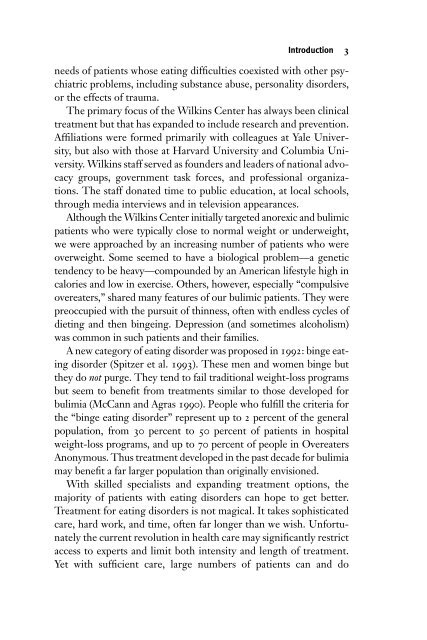Eating Disorders - fieldi
Eating Disorders - fieldi
Eating Disorders - fieldi
You also want an ePaper? Increase the reach of your titles
YUMPU automatically turns print PDFs into web optimized ePapers that Google loves.
Introduction 3<br />
needs of patients whose eating difficulties coexisted with other psychiatric<br />
problems, including substance abuse, personality disorders,<br />
or the effects of trauma.<br />
The primary focus of the Wilkins Center has always been clinical<br />
treatment but that has expanded to include research and prevention.<br />
Affiliations were formed primarily with colleagues at Yale University,<br />
but also with those at Harvard University and Columbia University.<br />
Wilkins staff served as founders and leaders of national advocacy<br />
groups, government task forces, and professional organizations.<br />
The staff donated time to public education, at local schools,<br />
through media interviews and in television appearances.<br />
Although the Wilkins Center initially targeted anorexic and bulimic<br />
patients who were typically close to normal weight or underweight,<br />
we were approached by an increasing number of patients who were<br />
overweight. Some seemed to have a biological problem—a genetic<br />
tendency to be heavy—compounded by an American lifestyle high in<br />
calories and low in exercise. Others, however, especially “compulsive<br />
overeaters,” shared many features of our bulimic patients. They were<br />
preoccupied with the pursuit of thinness, often with endless cycles of<br />
dieting and then bingeing. Depression (and sometimes alcoholism)<br />
was common in such patients and their families.<br />
A new category of eating disorder was proposed in 1992: binge eating<br />
disorder (Spitzer et al. 1993). These men and women binge but<br />
they do not purge. They tend to fail traditional weight-loss programs<br />
but seem to benefit from treatments similar to those developed for<br />
bulimia (McCann and Agras 1990). People who fulfill the criteria for<br />
the “binge eating disorder” represent up to 2 percent of the general<br />
population, from 30 percent to 50 percent of patients in hospital<br />
weight-loss programs, and up to 70 percent of people in Overeaters<br />
Anonymous. Thus treatment developed in the past decade for bulimia<br />
may benefit a far larger population than originally envisioned.<br />
With skilled specialists and expanding treatment options, the<br />
majority of patients with eating disorders can hope to get better.<br />
Treatment for eating disorders is not magical. It takes sophisticated<br />
care, hard work, and time, often far longer than we wish. Unfortunately<br />
the current revolution in health care may significantly restrict<br />
access to experts and limit both intensity and length of treatment.<br />
Yet with sufficient care, large numbers of patients can and do









